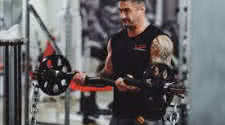Ways to Train with Negatives - Benefits of Negative Training Exercises

Negative Training Often Leads to Positive Results
Negative-Only Reps
An entire set of repetitions may be performed in a negative-only manner by having a training partner (or partners) raise the weight while you lower the weight. Essentially, the positive work is done by your spotter(s) and you do the negative. In a negative-only lying triceps extension, for example, your partner(s) would raise the weight into a position where your arms are fully extended (with no help from you). Your spotter(s) would then release the bar at the arms-extended position and you'd slowly lower the bar until it touches your forehead (or just behind your head). This procedure is repeated until muscular fatigue occurs.For safety and effectiveness, each negative-only repetition should be done slowly. M. Brzycki recommends that a negative rep be performed in 6-8 seconds, and that you do 11-15 negative-only reps for the glutes, 8-11 for the rest of the lower body and 5-9 for the upper body.
Remember, you can use more resistance in a negative-only exercise than in the same exercise performed in the traditional manner. A. Jones reported that eccentric strength is approximately 40% more than concentric strength in a fresh, unfatigued muscle. If you're doing negative-only exercises for the first time, then use a weight that's only slightly more than what you'd use in the traditional exercise. For example, if you can typically bench press 150 pounds for a prescribed number of repetitions, after your warm-up add about 10% more weight (an additional 15 pounds) when performing negative-only bench presses for the first time. After that, increase the resistance whenever you attain the maximum number of negative-only reps. Others claim the optimal eccentric resistance is 120% of the dynamic constant resistance.
The major disadvantage with negative-only exercise is that it almost always requires one or more spotters to lift the weight. Chins and dips are two common exercises that can be performed in a negative-only fashion without assistance. You can do negative-only chins by stepping or climbing up to the bar, then slowly lowering yourself under control to an extended position. Negative-only dips can be done in a similar fashion.
Negative-Accentuated Reps
The value of negative-accentuated reps is that they emphasize the eccentric component of an exercise yet can be performed without a spotter's help. The positive work is shared by both limbs, but the negative work is done by only one. In other words, the weight is raised with either arms or legs, then lowered with only one arm or leg. That makes the resistance twice as high during the negative phase as during the positive phase.In negative-accentuated reps on a leg extension, for example, you'd raise the weight to the extended position with both legs. You'd then move one leg carefully away from the resistance pad so that the weight is being held briefly in the fully extended position by only one leg. Then you'd lower the weight slowly and steadily using just that one leg.
A. Jones suggests raising the weight with both limbs in about 1-2 seconds, then lowering with one limb in about eight seconds. Furthermore, he recommends using 70% of the weight you'd normally use; if you last used 100 pounds on the traditional leg extension, you'd use 70 pounds as a starting point for a set of negative-accentuated reps. M. Brzycki believes you should perform 15-20 reps of negative-accentuated exercises for the glutes, 10-15 reps for the rest of the lower body and 6-12 reps for the upper body.
Though you can't do negative-accentuated exercises with a barbell, most machines will permit you to do repetitions in a negative-accentuated fashion.
Science Weighs In on Negatives
Because skeletal muscle can generate greater levels of tension during eccentric contractions, some scientists argue that if tension is the critical stimulus for increasing protein synthesis in muscle then training with eccentric contractions should provide a greater stimulus for hypertrophy than other contraction types. Let's take a cursory look at what a couple of recent studies say about eccentric training and muscle hypertrophy.E.J. Higbie and colleagues at the University of Georgia, Athens, compared the effects of 10 weeks of concentric and eccentric knee-extension training on quadriceps cross-sectional area using magnetic resonance imaging (MRI). Their results showed that quadriceps cross-section area increased significantly more in the eccentric-training-only group (6.6%) compared to the concentric-training-only group (5%).
In another study, T. Hortobagyi, et al, at East Carolina University in Greenville, North Carolina, looked at the changes in muscle fiber size after subjects went through 12 weeks of either concentric or eccentric leg training. Type I (aerobic) muscle fiber areas didn't change significantly in either group, but Type II (anaerobic) fiber area increased approximately 10 times more in the eccentric than in the concentric group. These researchers concluded that maximal eccentric contractions are associated with greater muscle hypertrophy than concentric exercise.